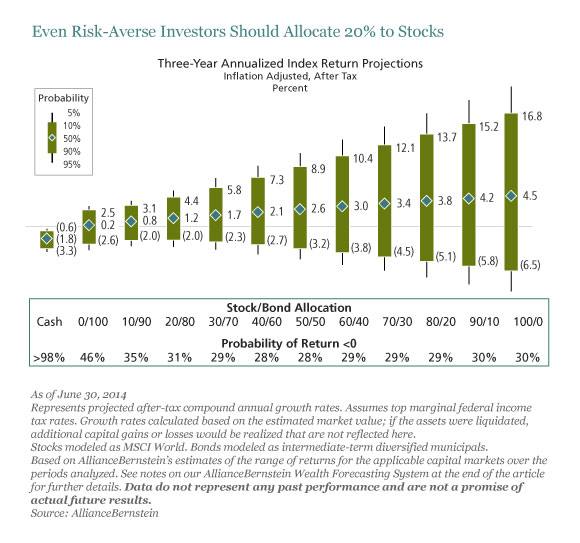by Seth J. Masters and John McLaughlin, AllianceBernstein
Many investors with little appetite for risk think cash is the safest asset class. After all, if you have no investments, you have no investment risk. That’s true enough, but it’s reassuring only if you ignore inflation and taxes. And of course, most individuals do pay taxes and everyone experiences inflation.
Take inflation and taxes into account, and investors holding nothing but cash are virtually certain to be poorer in real terms three years from now. An all-bond portfolio is a somewhat better proposition, but it, too, could well lose purchasing power in the market environment we anticipate. Unfortunately, no portfolio is completely safe after taxes and inflation.
Fortunately, there is a much better way to control risk than keeping all your money in cash or bonds: diversifying through a modest addition of stock to the mix. By our calculation, even the most risk-averse investors should hold at least 20% of their portfolios in stocks—assuming that they don’t have large bills to pay in the very near term.
The Display shows how we came to this conclusion. Using our Wealth Forecasting System, we projected annualized three-year returns for portfolios with a range of asset allocations. In typical markets, after inflation and taxes, we forecast that an all-cash portfolio (on the extreme left) will lose 1.8% a year. In great markets, it will lose 0.6%, and in hostile markets, the losses will mount to 3.3% a year. For all these forecasts, we’ve assumed a US investor in the highest federal tax bracket.
Directly to the right of the all-cash portfolio, you can see that we expect an all-bond portfolio to deliver 0.2% a year in typical markets, 2.5% in great markets and (2.6)% in hostile markets.
In comparison to the all-cash and all-bond choices, we predict that an all-stock portfolio (on the extreme right) will deliver a lot more in typical and great markets, but also lose more in hostile markets, yielding returns of (6.5)% annualized. This may seem very mild compared to memories of 2008, but in fact, annualized returns for the three years from 2007 to 2009 were not a great deal worse: (7.2)%. Our analysis indicates that the probability of another loss this large is less than 10%.
Between the all-bond and the all-stock portfolios, we’ve estimated the range of returns you are likely to experience across the full spectrum of diversified portfolios.
For a taxable investor whose primary goal is minimizing the risk of real losses, the 20/80 asset mix offers better returns than the all-cash or all-bond portfolio in positive market environments and smaller losses when market returns are negative. To the right of the 20/80 portfolio, the more stock exposure you add, the better you do when markets are typical or better, but the worse you do when market returns are poor.
Fear (and greed) can prompt investors to make irrational choices. Cash feels safe, but a closer look shows otherwise. Risk-averse investors who can overcome their emotional bias against owning any stock can improve their returns and reduce their real downside risk.
The AllianceBernstein Wealth Forecasting System uses a Monte Carlo model that simulates 10,000 plausible paths of return for each asset class and inflation rate and produces a probability distribution of outcomes. The model does not draw randomly from a set of historical returns to produce estimates for the future. Instead, the forecasts (1) are based on the building blocks of asset returns, such as inflation, yields, yield spreads, stock earnings and price multiples; (2) incorporate the linkages that exist among the returns of various asset classes; (3) take into account current market conditions at the beginning of the analysis; and (4) factor in a reasonable degree of randomness and unpredictability.
AllianceBernstein does not provide tax, legal or accounting advice. It does not take an investor’s personal investment objectives or financial situation into account; investors should discuss their individual circumstances with appropriate professionals before making any decisions.
Seth J. Masters is Chief Investment Officer of Bernstein Global Wealth Management, and John F. McLaughlin, CFA, is a Research Analyst in the Wealth Planning and Analysis Group at Bernstein Global Wealth Management, a unit of AllianceBernstein (NYSE:AB).
Copyright © AllianceBernstein















